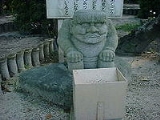
Amanojaku
Encyclopedia

Demon
call - 1347 531 7769 for more infoIn Ancient Near Eastern religions as well as in the Abrahamic traditions, including ancient and medieval Christian demonology, a demon is considered an "unclean spirit" which may cause demonic possession, to be addressed with an act of exorcism...
-like creature in Japanese
Japan
Japan is an island nation in East Asia. Located in the Pacific Ocean, it lies to the east of the Sea of Japan, China, North Korea, South Korea and Russia, stretching from the Sea of Okhotsk in the north to the East China Sea and Taiwan in the south...
folklore
Folklore
Folklore consists of legends, music, oral history, proverbs, jokes, popular beliefs, fairy tales and customs that are the traditions of a culture, subculture, or group. It is also the set of practices through which those expressive genres are shared. The study of folklore is sometimes called...
. It is usually depicted as a kind of small oni, and is thought to be able to provoke a person's darkest desires and thus instigate him into perpetrating wicked deeds.
One of the amanojaku's best known appearances is in the fairytale Urikohime (瓜子姫, "melon princess"), in which a girl miraculously born from a melon is doted upon by an elderly couple. They shelter her from the outside world, and she naively lets the amanojaku inside one day, where it kidnaps or devours her, and sometimes impersonates her by wearing her flayed skin.
Amanojaku in Religion
The amanojaku is commonly held to be derived from AmanosagumeAmanozako
Amanozako is a monstrous goddess mentioned in the Kujiki, an ancient Japanese text, which states that she originated when Susanoo let his own ferocious spirit build up inside him until he vomited her out...
(天探女), a wicked deity in Shintō
Shinto
or Shintoism, also kami-no-michi, is the indigenous spirituality of Japan and the Japanese people. It is a set of practices, to be carried out diligently, to establish a connection between present day Japan and its ancient past. Shinto practices were first recorded and codified in the written...
myth
Mythology
The term mythology can refer either to the study of myths, or to a body or collection of myths. As examples, comparative mythology is the study of connections between myths from different cultures, whereas Greek mythology is the body of myths from ancient Greece...
, which shares the amanojaku's contrary nature and ability to see into a person's heart, "a very perverted demon".
The creature has also entered Buddhist thought, perhaps via syncretism
Syncretism
Syncretism is the combining of different beliefs, often while melding practices of various schools of thought. The term means "combining", but see below for the origin of the word...
with the yaksha
Yaksha
Yaksha is the name of a broad class of nature-spirits, usually benevolent, who are caretakers of the natural treasures hidden in the earth and tree roots. They appear in Hindu, Jain and Buddhist mythology. The feminine form of the word is ' or Yakshini .In Hindu, Jain, and Buddhist mythology,...
, where it is considered an opponent of Buddhist teachings. It is commonly depicted as being trampled on and subdued into righteousness by Bishamonten
Vaisravana
' or ' also known as Jambhala in Tibet and Bishamonten in Japan is the name of the chief of the Four Heavenly Kings and an important figure in Buddhist mythology.-Names:...
or one of the other Shitennō
Four Heavenly Kings
In the Buddhist faith, the Four Heavenly Kings are four gods, each of whom watches over one cardinal direction of the world.The Kings are collectively named as follows:...
. In this context it is also called a jaki (邪鬼).
Manga references
- In Nurarihyon no MagoNurarihyon no MagoNura: Rise of the Yokai Clan, known in Japan as is a manga series written and illustrated by Hiroshi Shiibashi. The series was first published in Shueisha as a oneshot in 2007. The manga has been continuously serialized in the Japanese manga anthology Weekly Shōnen Jump since March 2008 and has...
, an amanojaku named Awashima is revealed to be male during the day and female at night.
External links
- Fujino Bunraku 2001 (contains mythological information and images)

